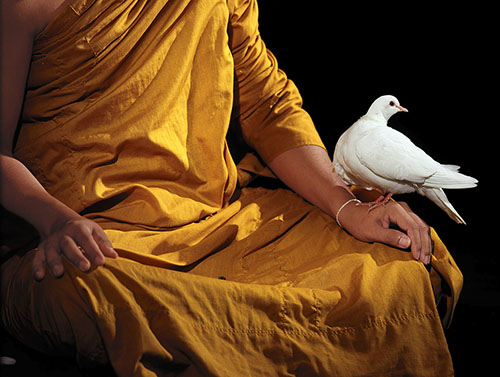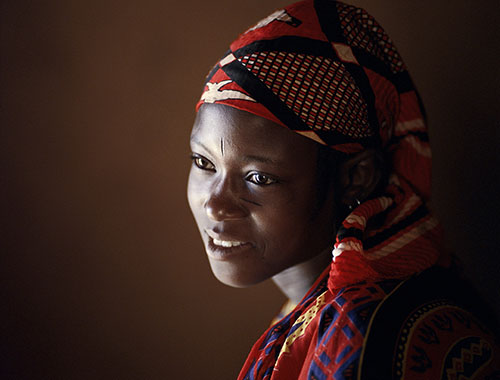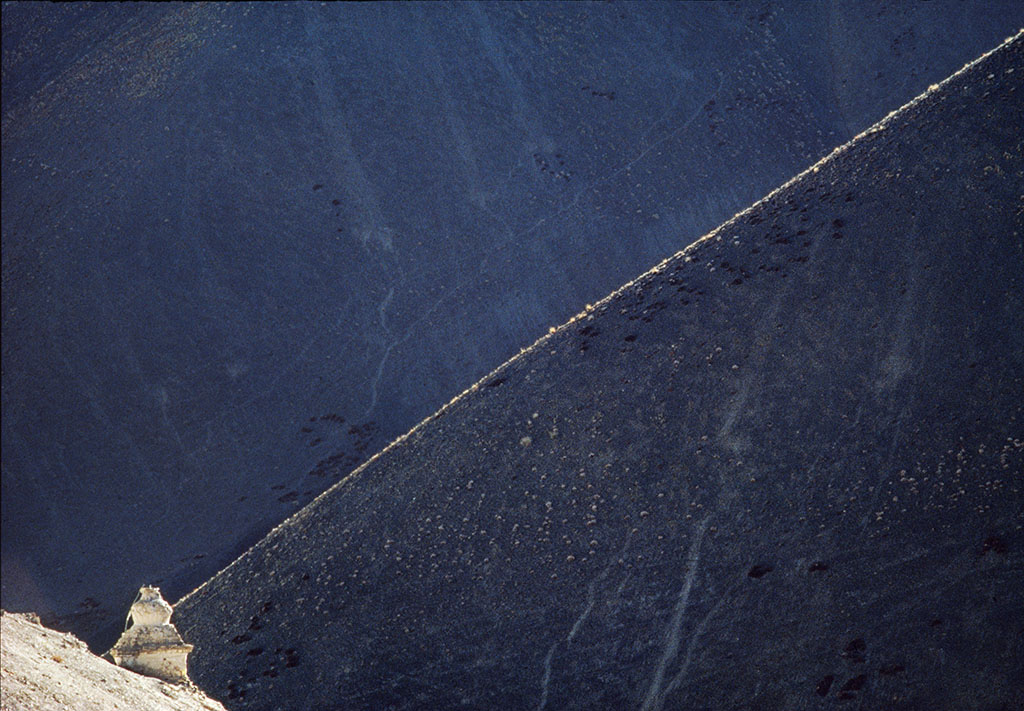Stories
- Meeting of Asia
- Meeting of Africa
- Meeting of Latin America
Meeting of Asia
April 2007 ⎪ Ever since I first saw it. I have dreamt to photograph a scene that filled me with wonder twenty years ago in Myanmar: in the enclosure of the Shwedagon golden pagoda, a monk was meditating and a dove came to rest on his knees. The monk was so peaceful that the dove fell asleep. At the time I didn’t want to get closer as I was afraid to spoil this harmonious moment, but I have never forgotten this magnificent picture.
This year, ever since I arrived in Asia 7 months ago, I have waited to live this moment again in all the pagodas I have visited. But I have never witnessed this scene again. We thus decided together with Noonie, my Thai assistant who has worked with me for the past 3 months, to recreate it in a studio in Bangkok. However, organising this photo shot was by no means simple: we needed both a dove who would come to rest and a monk who would accept to come to the studio. It is no easy task to ask a monk in Thailand to do this, as monks are a highly respected part of society. However, Noonie, who always has a solution, asked her aunt to contact a monk to whom she had given a donation allowing him to print holy texts. This monk was currently on a meditation retreat in Cambodia, so we waited for a week. Meanwhile, Noonie purchased Piu Piu, our model dove, who we accommodated in a beautiful and spacious cage. Back from his retreat, the Monk questioned me at great length over the phone as to the reason for this photo and the message it would convey.
“Venerable Mahar Pin Buddawiriyo, I would like to photograph a man on the path to Enlightenment and a bird that is a messenger of peace. This picture will help illustrate the “Wisdoms of Humanity” to show that the world is built through the determination of mankind”.
The Monk accepted the invitation and we booked a studio. Noonie went to fetch him, two hours by car from Bangkok. During this time, we installed the lights and prepared the setting. In his cage, Piu Piu was panic-stricken. I warned the studio assistance team: “We are going to welcome a monk just back from a retreat. On his arrival, we must communicate by gestures only. There must not be a sound”. However, I didn’t have to worry as in Thailand monks are highly respected. While awaiting his arrival, I remained alone for a while to adopt a state of positive emotion that would allow me to honour him by harmonious thoughts.
The Monk arrived, smiling, draped in his large yellow gown and radiating a profound sense of serenity. Noonie invited him to sit and, kneeling, spoke to him, quietly, her hands clasped in prayer. Likewise, I offered him a garland of jasmine and roses. The Monk spoke softly with a distant gaze: he was still in the world of his retreat. We barely spoke to him since he was not talkative, simply satisfied. I attempted to explain to him the photo I wished to take, but he interrupted me with a reassuring gesture and quietly got up to sit cross-legged on the stage. We fetched Piu Piu who was flapping her wings in the cage and tried to reassure her. The studio was now completely silent: the Monk had closed his eyes, clasped his hands on his knees, with his palms in the alms receiving position. The assistants were all completely still behind the projectors. We walked on tip-toe. Only Piu Piu made some noise while trying to get away from us. We placed the dove on the Monk’s knees, but Piu Piu flew away. Immersed in deep meditation, his eyes closed, the Monk did not move. We retrieved the dove that had taken refuge on a metal girder and put her back on the Monk’s knees. Piu Piu flew off again. You could feel the emotion in the studio, while, anxiously, each assistant sought to cross the dove’s eyes. We brought back the dove that Noonie cuddled in her hands. The Monk seemed absent, in a world beyond our reach, like a statue that appears living and gives off a vibration that, while imperceptible, is universally reassuring. Noonie placed the dove on his knees like a delicate treasure. Piu Piu settled there and started to coo. She would not fly off now. We were filled with a feeling of quiet tranquillity, transporting us to another world. The studio became a sanctuary of peace. Maybe an hour went by without anything happening, without anything moving. We could have passed two or three hours like this: we were in another silence, another time. Piu Piu dozed off, her wings folded on the Monk’s knees. I took my photos, those I had dreamt of for the past 20 years. In my view finder I took pleasure in imagining that were the Monk to lift his arm, the dove would fly up to his hand, which would be magnificent. But in his meditation, his eyes closed, the Monk was far away and inaccessible. However, a few minutes later, he unfolded his arm, so gently I thought I was dreaming. Pieu Pieu woke and climbed onto his arm. Slowly, so slowly he seemed weightless, the Monk lifted his arm and Pieu Pieu settled on his hand. Plunged in his meditation, the Monk remained in this position for a long time, not moving, his hand stretched out. A thought crossed my mind: maybe this picture would be more meaningful with the dove on one of the Monk’s knees. Shortly afterwards, the Monk lowered his arm as lightly as the feather of a chick falling from the nest, with the bird on his hand. He assumed his initial posture and Pieu Pieu went to perch on his knee. Then, after a time I cannot measure, the Monk slowly opened his eyes and smiled. I clasped my hands together. I wanted to cry.
Later, Mahar Pin Buddawiriyo was to tell me what he transmitted by thought to the dove when she settled on his knees: “Whether you are the animal and I the human, we are together to complete something that is important: we have both been chosen as messengers of peace for our world. This is an opportunity to deliver our virtues, for you and for me. We shall help each other”. He then blessed the bird that, tamed, started to follow his instructions.
Piu Piu became the mascot of Noonie’s family, who opened wide his cage. The dove flew off to freedom but returns regularly, like a blessing.ÃÂ
Aller en haut
ÃÂ
Meeting of Africa
January 2005 ⎪ Certain African populations suffer from the barbaric approach of travellers pointing cameras at them like rifles. I experienced this in the north of Burkina Faso. Africa is largely misunderstood: in spite of all the human values it has to share, it is the most neglected continent on our planet. Burkina Faso is a poor African country. In the north, the Sahel region, dried out by the sand storms, is even poorer and the nomad settlement of around a hundred Peul shepherds that we are heading for is among the poorest of the poor. Ibrahim, my guide, is taking my assistant, Tashi, and me to this camp, located a few kilometres from Gorom-Gorom. In the desert, dotted with large dry trees, the sprawling camp is made of bits of canvas crudely knotted together. Our arrival causes a bit of a stir. Women, each one more beautiful than the last, surround the car, accompanied by a horde of children from the tents. Through the windows they wave their arms: “No photos, no photos!” They have obviously had some bad experience. My cameras are in the boot. I never enter a new place with a camera around my neck: I’m no wildlife hunter.
There are no men at the camp. They leave during the dry season to seek work in the towns of border countries to supplement the derisory income made from the sale of their scrawny animals. Children, walking barefoot on the scorching sand, take us by hand and lead us from tent to tent to meet their mothers and deeply wrinkled grandmothers. In the shade of a much-mended canvas, a skeletal child lies sick on the sand. I cannot leave this child in these conditions, he needs treatment. I want to take him to hospital, but as we tour the camp, I realise that there are a great many very weak children and sick elderly people. Instead, I decide to hire a doctor in Gorom-Gorom to come to treat them.
The next morning, the doctor sets up his consultation room in one of the camp’s tents. The sick queue up outside in the blazing sun. Meanwhile, women offer us tea, made from murky water drawn from a distant water-hole. Their main concern is survival: they are hungry. They are rationing their grain because they do not know when the men will be back and how much money they will bring. At Gorom-Gorom market, the milk they obtain from their bony cattle does not sell well. The doctor spends the morning examining the sick, then we drive him back to town to buy badly-needed drugs. Two women come with us and together we fill the pick-up with millet, vegetables and fruit. Upon our return to the camp, the women form a large circle around the car, dancing and singing. Feverishly, they set about lighting twig fires, scrubbing and polishing pots to prepare the feast. While the food is cooking, the children’s eyes devour the pots bubbling over the flames. We could make a book of all the overwhelming scenes before us, but watching these silent children, I am ashamed of my camera and my wealth. I am overcome by the injustice of this world. Sitting in a ring in the sand around the pots, the children eat their meal first in a religious silence. The women wait for them to eat their fill before finishing the dishes that the children then lick clean. Suddenly, one of them asks me, “Why don’t you take photos?”
The next day, I come back with more food. The women are waiting for me, dressed in their festive robes, with long strings of beads in their black hair. They insist on me taking photos and we spend the day having fun, flirting with the camera, as if it was a feast day. In the afternoon, Ibrahim and Tashi drive back to town, returning once again with the car loaded with millet and vegetables. As we leave the camp in the evening, the women make us promise to come back again the next morning before we leave so that they can say goodbye on leaving. So, we go back at dawn, before the sun starts to bake the desert. At the entrance to the camp, on either side of the sandy track, the women have laid out twenty-three jugs of milk. They are standing behind them, once again dressed up in their jewellery. They have been milking their cattle all night to give us all they had. Ceremoniously, we drink a jug of milk to honour their gift, each mouthful accompanied by a glance of complicity, a smile of joy tinged with emotion. We say goodbye, then goodbye again through our windows while they dance with elation in a wide circle around the car. Out of the back window, we can still see them, fading into a cloud of dust, waving their arms, dancing along the track.
Every year, Ibrahim phones me from Gorom-Gorom to give me news of this nomad settlement and convey my news to the camp. The sale of these photos has enabled Hope, the association founded by Danielle and myself, to renovate the deep well that has been sanded up at the camp for years.
Meeting of Latin America
December 2005 ⎪ At an altitude of 4,100m, Potosi is the highest town in the world. Once, it was also the largest, when Potosi’s gold mines were making the fortune of the Spanish kingdom from the 15th to 18th century. The gold was extracted by the Indian and African slaves who survived being chained up in the ships’ holds during the long voyage across the ocean. For three centuries, seven million of these slaves died working in the mountains. Potosi has a heavy past. The mountain is now riddled with tunnels and has been bled of its gold, but Indian miners still attempt to extract the last of its tin veins from the dangerous tunnels you sometimes have to crawl through, as the slaves once did. I am overwhelmed before even coming here.
We spend three days inside the mountains, taking photos of men who earn their survival by ruining their life expectancy. In the evening, they leave the mines, faces worn and grey with dust, witnessing the duress of their labour. But their eyes are proud: from the depths of the earth, they have brought enough to feed their families for another day. On the third day, at the end of a narrow tunnel in the gleam of our head lamps, we meet Tomas in a cloud of dynamite dust. He is only twelve, but his face is already serious, too serious. He is carrying the ore on his back to a wobbly wheelbarrow that is far too big for him. In the light of our lamps, he tell us in a small voice how his father died in the mine. When his mother died last year, he left school and came to work in the dark tunnels. It is very damp and the little boy is shivering in the icy draught, barefoot in his over-sized boots sunk deep in the mud. I cannot walk out of the mine and leave this child behind. We take him by the hand and go out together.
Helena, a young Indian campaigner for the rights of children, comes with us to meet Tomas’ elder brother, who also works at the mine. He, his wife and their new-born baby live with Tomas in one miserable room. Tomas has to work to help pay for his keep and contribute to the family expenses. We offer to enrol Tomas in school and pay his contribution to the family. Tomas’ brother accepts, showing neither joy nor regret, just a certain resignation to a fatality that escapes him. We enrol Tomas as a boarder in a good school, two hours away from Potosi, hoping to distance him from his heavy past and this mine that has obliterated all the light from his life. For two months, Tomas seems to settle down into his new life. He is soon the best in the class at maths. Two months later, on my way through Bolivia, I come to visit him with Nora. We learn that Tomas has just run away from school. By chance, we find him wandering the streets of Potosi. Was he lonely? Had he been treated unfairly? We take him with us for four days to try and understand what has happened and restore his confidence.
We drive two hours back to his school and meet the headmaster and teachers. Together we decide to give Tomas some psychological support. We look into countless possibilities to help Tomas. Julio promises to visit him each time he comes to Potosi. Nora offers to take him home with her to Peru in two months at the end of our trip to give him some daily love and care. Tomas’ eyes are wet with joy.
“You see Tomas, you have a new family: in Europe, in Peru and in La Paz!” I ask him to promise to continue his studies until Nora comes back for him in two months. He kisses me, cries in my arms and promises that he will. But one month later, Tomas runs away from the boarding school once more. Too hard, too alone, too orphaned to accept life? I do not know. When we hear the news, we are already in North America.
Nora flies back immediately to try and find Tomas but in vain.
Tomacito, my little Tomas, we would have so liked to help you leave the dark future of your mine and guide you to your first horizon. But you represent all the difficulties of your Indian people, generations of scorned men who resign themselves to their destiny of being exploited and condemned, leaving them with no faith in the future …
Potosi still weighs upon me like a ball and chain.
Aller en haut
ÃÂ














 Follow us on Facebook
Follow us on Facebook Say «I like» to Olivier
Say «I like» to Olivier Watch our videos on YouTube
Watch our videos on YouTube Subscribe to our newsletter
Subscribe to our newsletter